Breaking: Can dance make the Olympics more urban?
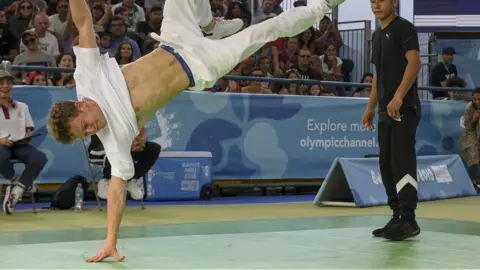 Getty Images
Getty ImagesBreaking, or breakdancing, could be part of the Olympics for the first time, after it was proposed to the International Olympic Committee.
The lead organiser for the Paris 2024 Games said introducing breaking - along with surfing, climbing and skateboarding - would make the Olympics "more urban".
It comes after breaking was included in the Youth Olympic Games in Buenos Aires in 2018.
But where exactly does the dance form come from? And would Team GB compete?
The beginnings of breaking
Also known as b-boying or b-girling, breaking originated in New York City in the 1970s.
Inspired by percussive drum rhythms from rock funk to Latin beats, the dance style features energetic moves such as windmills and handspins.
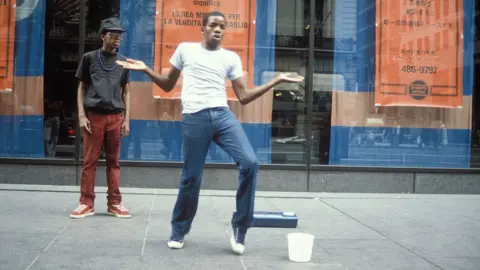 Getty Images
Getty ImagesStarting on the pavements of the South Bronx - where there was high crime and poverty - breaking was a powerful means of expression.
But the dance form spread far beyond its New York roots. In the 1980s, it featured in advertisements for Burger King, Pepsi and Coca-Cola, as well as in films including Wild Style, Beat Street and Breakdance.
And in 1985, hip hop dance group the Rock Steady Crew performed for then US President Ronald Reagan. Footage in CNN's archives also shows First Lady Nancy Reagan taking a lesson in breaking.
The dance form became so popular in the UK that US rap group Break Machine had three UK top 40 hits in 1984 - Street Dance, Break Dance Party and Are You Ready.
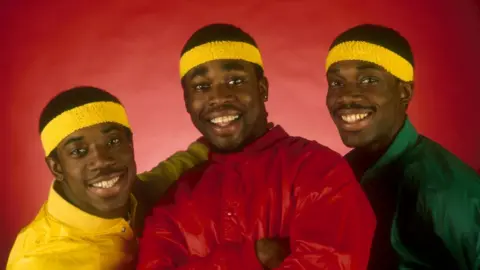
Across the UK, young people clad in brightly coloured tracksuits and skiwear began to perform gravity-defying moves on scraps of lino laid down on shopping centre and nightclub floors.
Nottingham became a hub for breaking after US dance troupe, the WFLA crew, performed at the city's Old Market Square in 1983.
Dance collectives formed that gathered in the city centre's Rock City nightclub to do battle.
The dance form lost popularity in the late 1980s, but has had a number of revivals since.
 Getty Images
Getty ImagesHow could breaking work at the Olympics?
If the International Olympic Committee accepts breaking as an event for 2024, the Youth Olympic Games has provided a successful template.
The 2018 competition was split into men's breaking, women's breaking and mixed team breaking, which involved one man and one woman.
Competitors took part in three phases:
- An individual performance in front of judges, with the highest-rated breakers progressing
- A round-robin format, with each breaker performing in multiple one-on-one "battles"
- Knock-out rounds to compete for medals, featuring the four top round robin competitors
The same format is expected to be used if Paris gets the go-ahead, however the mixed team event is set to be dropped.
 Getty Images
Getty ImagesWhat are the judges looking for?
As in other dance-sport events featured at the Olympics, such as ballroom dancing, judges rate competitors on a variety of criteria.
The 2018 Youth Olympics used the Trivium Value System, which was co-created by one of the judges of the event, Londoner DJ Renegade.
It involves three broad areas of assessment: physical quality, interpretative quality and artistic quality.
A breaker's technique, variation, creativity, spontaneity and individuality all act as "faders" that then affect the final score.
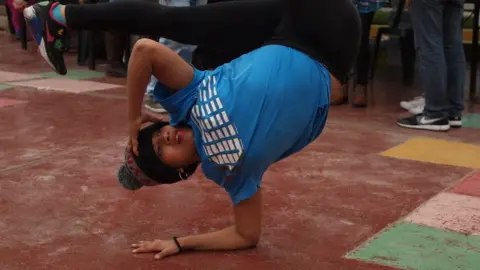 Getty Images
Getty ImagesWould Team GB send athletes to compete in Paris?
No dancers from the UK competed in breaking at the Youth Olympics last year.
Team GB told the BBC it was not invited to take part at the event, but had taken note of "the popularity of breakdancing amongst fans there".
When asked about the possibility of a British cohort competing in 2024, Team GB said it was currently focusing on the 2020 Olympics in Tokyo but would "work with the relevant bodies to develop our relationships at the appropriate time".
What's the reaction been in the UK?
DJ Renegade, who has been involved in UK breaking since the 1980s, said the proposal for the event to be at the 2024 Olympics was "one of the most exciting things that's happened in our scene".
"People were mentioning this back in 1983," he told the BBC.
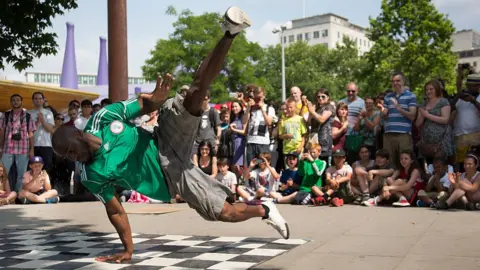 Getty Images
Getty ImagesRenegade says breakers from the UK are "as good as anyone" on the international stage but stresses that funding is needed to take the next step.
"We need facilities for training," he said.
"Right now people are training in train stations.
"We don't have any gyms or studios, you have to pay for that stuff. It would be nice if there was an academy where you can go and learn about the culture."
Currently, children who want to be involved can compete in regional events run by the British Breaking League in London, Leeds, Newcastle, Coventry and Birmingham.
For adults, the UK B-Boy Championships showcases dancers from around the world.
